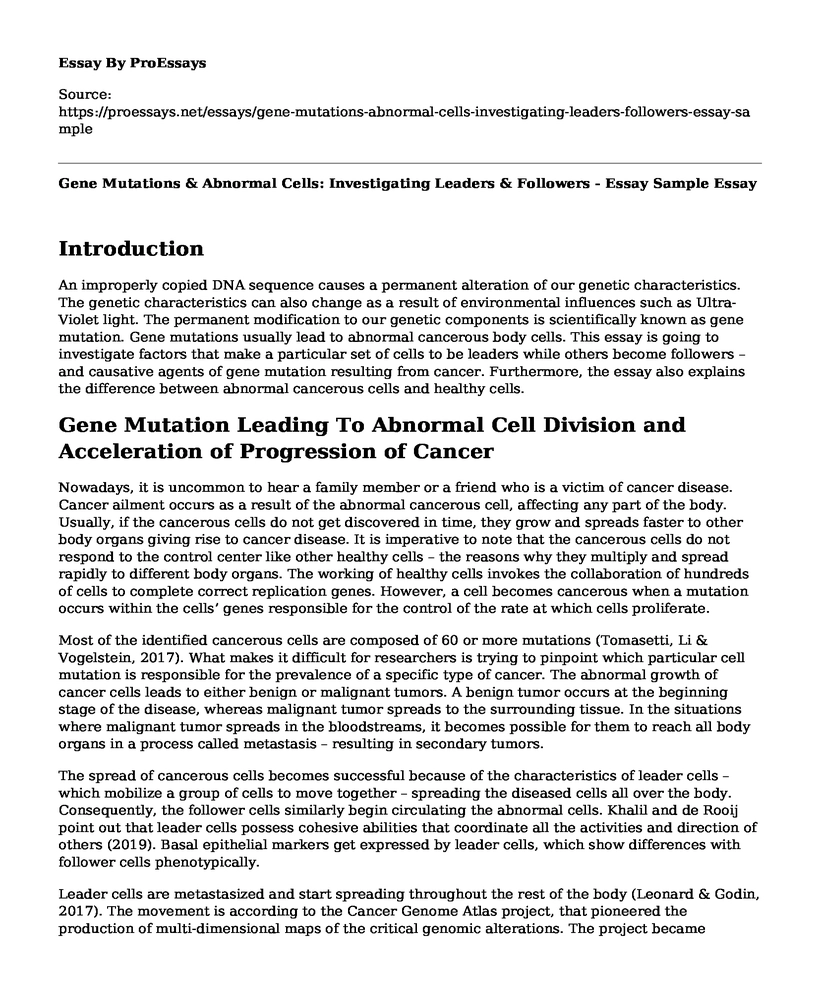Introduction
An improperly copied DNA sequence causes a permanent alteration of our genetic characteristics. The genetic characteristics can also change as a result of environmental influences such as Ultra-Violet light. The permanent modification to our genetic components is scientifically known as gene mutation. Gene mutations usually lead to abnormal cancerous body cells. This essay is going to investigate factors that make a particular set of cells to be leaders while others become followers – and causative agents of gene mutation resulting from cancer. Furthermore, the essay also explains the difference between abnormal cancerous cells and healthy cells.
Gene Mutation Leading To Abnormal Cell Division and Acceleration of Progression of Cancer
Nowadays, it is uncommon to hear a family member or a friend who is a victim of cancer disease. Cancer ailment occurs as a result of the abnormal cancerous cell, affecting any part of the body. Usually, if the cancerous cells do not get discovered in time, they grow and spreads faster to other body organs giving rise to cancer disease. It is imperative to note that the cancerous cells do not respond to the control center like other healthy cells – the reasons why they multiply and spread rapidly to different body organs. The working of healthy cells invokes the collaboration of hundreds of cells to complete correct replication genes. However, a cell becomes cancerous when a mutation occurs within the cells’ genes responsible for the control of the rate at which cells proliferate.
Most of the identified cancerous cells are composed of 60 or more mutations (Tomasetti, Li & Vogelstein, 2017). What makes it difficult for researchers is trying to pinpoint which particular cell mutation is responsible for the prevalence of a specific type of cancer. The abnormal growth of cancer cells leads to either benign or malignant tumors. A benign tumor occurs at the beginning stage of the disease, whereas malignant tumor spreads to the surrounding tissue. In the situations where malignant tumor spreads in the bloodstreams, it becomes possible for them to reach all body organs in a process called metastasis – resulting in secondary tumors.
The spread of cancerous cells becomes successful because of the characteristics of leader cells – which mobilize a group of cells to move together – spreading the diseased cells all over the body. Consequently, the follower cells similarly begin circulating the abnormal cells. Khalil and de Rooij point out that leader cells possess cohesive abilities that coordinate all the activities and direction of others (2019). Basal epithelial markers get expressed by leader cells, which show differences with follower cells phenotypically.
Leader cells are metastasized and start spreading throughout the rest of the body (Leonard & Godin, 2017). The movement is according to the Cancer Genome Atlas project, that pioneered the production of multi-dimensional maps of the critical genomic alterations. The project became spearheaded by the National Cancer Institute and National Human Genome Research Institute in 2005 (Leonard & Godin, 2017). The follower cells then get transported to other body organs. Cancerous cells are different from healthy cells since they allow the spread of disease. It is hard for scientists to predict, track, and stop the leader cells, causing metastasis because the coding of tumor and cancer cell happen differently. The leader cells are what causes the cancerous disease to spread all over, bringing along follower cells to the new affected body parts of people (Leonard & Godin, 2017).
Conclusion
In conclusion, the mutation causes an alteration of the cells resulting in cancerous tumors. The two types of cancerous cells are benign and malignant tumors. The benign tumor usually stays in a particular cell organ, whereas the malignant tumor spreads to surrounding tissues. The spread of cancer to other parts of the body happens because of leader cells. These cells can determine the directions the cancerous cells take. As a result, the follower cells also spread and metastasize to other parts of the body.
References
Khalil, A. A., & de Rooij, J. (2019). Cadherin mechanotransduction in leader-follower cell specification during collective migration. Experimental cell research, 376(1), 86-91. https://doi.org/10.1016/j.yexcr.2019.01.006
Leonard, F., & Godin, B. (2017). Unraveling bio-social hierarchy in cancer collective invasion: the symbiosis between leaders and followers. Editorial, 6(6). 10.21037/tcr.2017.08.09
Tomasetti, C., Li, L., & Vogelstein, B. (2017). Stem cell divisions, somatic mutations, cancer etiology, and cancer prevention. Science, 355(6331), 1330-1334. 10.1126/science.aaf9011
Cite this page
Gene Mutations & Abnormal Cells: Investigating Leaders & Followers - Essay Sample. (2023, Aug 27). Retrieved from https://proessays.net/essays/gene-mutations-abnormal-cells-investigating-leaders-followers-essay-sample
If you are the original author of this essay and no longer wish to have it published on the ProEssays website, please click below to request its removal:
- Effects of Light Intensity and Carbon Dioxide on Photosynthesis
- Biological Basis of Genetically Modified Crop Plants Essay
- Exploring the Rich Biodiversity of Amazon Rainforest - Essay Sample
- Essay Sample on Changing Human-Environment Interactions: Impact on Life
- Essay Example on Skeletal Muscles: Powerhouse of Movement & Protection
- Research Paper on Bats & Viruses: The Spillover Effect & Coronavirus
- Essay Example on Primate Evolution: Changes in Locomotion & Body Structure







